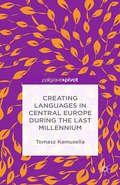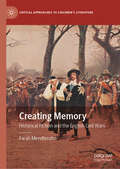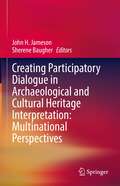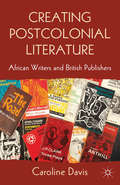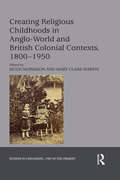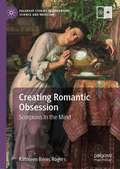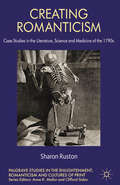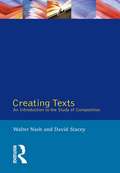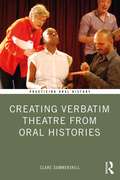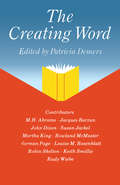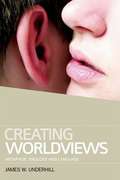- Table View
- List View
Creating Inclusive Writing Environments in the K-12 Classroom: Reluctance, Resistance, and Strategies that Make a Difference
by Angela StockmanTimely and accessible, this book offers tangible strategies that will help teachers plan and sustain writing workshop experiences that are responsive to the needs of their specific students. Angela Stockman helps teachers understand why some writers may fail to meet their expectations and how to help all writers reach their fullest potential. Organized in three parts, this book reframes common narratives about resistant writers, empowers teachers to design, lead and refine their workshop, and provides a toolkit to do so. The appendices and eResources included provide teachers with instructions for mini-lessons and learning targets that support multimodal composition, perfect for pre-service and in-service teachers.
Creating Inclusive Writing Environments in the K-12 Classroom: Reluctance, Resistance, and Strategies that Make a Difference
by Angela StockmanTimely and accessible, this book offers tangible strategies that will help teachers plan and sustain writing workshop experiences that are responsive to the needs of their specific students. Angela Stockman helps teachers understand why some writers may fail to meet their expectations and how to help all writers reach their fullest potential. Organized in three parts, this book reframes common narratives about resistant writers, empowers teachers to design, lead and refine their workshop, and provides a toolkit to do so. The appendices and eResources included provide teachers with instructions for mini-lessons and learning targets that support multimodal composition, perfect for pre-service and in-service teachers.
Creating Intelligent Content with Lightweight DITA (ATTW Series in Technical and Professional Communication)
by Carlos EviaCreating Intelligent Content with Lightweight DITA documents the evolution of the Darwin Information Typing Architecture (DITA) – a widely used open standard for structuring technical content. DITA has grown in popularity and features since its origins as an internal grammar for structuring technical documentation at IBM. This book introduces Lightweight DITA (LwDITA, which should be read as "Lightweight DITA") as a proposed version of the DITA standard that reduces its dependence on complex Extensible Markup Language (XML) structures and simplifies its authoring experience. This volume aims to reconcile discrepancies and similarities in methods for authoring content in industry and academia and does so by reporting on DITA’s evolution through the lens of computational thinking, which has been connected in scholarship and media to initiatives for learning to code and programming. Evia’s core argument is that if technical communicators are trained with principles of rhetorical problem solving and computational thinking, they can create structured content in lightweight workflows with XML, HTML5, and Markdown designed to reduce the learning curve associated with DITA and similar authoring methodologies. At the same time, this book has the goal of making concepts of structured authoring and intelligent content easier to learn and teach in humanities-based writing and communication programs. This book is intended for practitioners and students interested in structured authoring or the DITA standard.
Creating Intelligent Content with Lightweight DITA (ATTW Series in Technical and Professional Communication)
by Carlos EviaCreating Intelligent Content with Lightweight DITA documents the evolution of the Darwin Information Typing Architecture (DITA) – a widely used open standard for structuring technical content. DITA has grown in popularity and features since its origins as an internal grammar for structuring technical documentation at IBM. This book introduces Lightweight DITA (LwDITA, which should be read as "Lightweight DITA") as a proposed version of the DITA standard that reduces its dependence on complex Extensible Markup Language (XML) structures and simplifies its authoring experience. This volume aims to reconcile discrepancies and similarities in methods for authoring content in industry and academia and does so by reporting on DITA’s evolution through the lens of computational thinking, which has been connected in scholarship and media to initiatives for learning to code and programming. Evia’s core argument is that if technical communicators are trained with principles of rhetorical problem solving and computational thinking, they can create structured content in lightweight workflows with XML, HTML5, and Markdown designed to reduce the learning curve associated with DITA and similar authoring methodologies. At the same time, this book has the goal of making concepts of structured authoring and intelligent content easier to learn and teach in humanities-based writing and communication programs. This book is intended for practitioners and students interested in structured authoring or the DITA standard.
Creating Language Crimes: How Law Enforcement Uses (and Misuses) Language
by Roger W. ShuyThis book by Roger W. Shuy, the senior figure in forensic linguistics, is the first to explain in an accessible way the vital role that linguistic evidence and its proper analysis play in criminal investigations. Shuy provides compelling case studies of how language functions in investigations involving, among others, wired undercover operatives, and the interrogation of suspects. He makes the point that language evidence can be as important as physical evidence, but yet does not enjoy the same degree of scrutiny by investigators, attorneys, and the courts. Beyond this, however, his more controversial thesis is that police frequently misuse or manipulate language, using various powerful controversial strategies, in order to intentionally create an impression of the targets' guilt or even to get them to confess. This book makes its case by analyzing a dozen criminal cases involving a variety of crimes, such as fraud, bribery, stolen property, murder, and others. About half involve co-operating witnesses who do the tape recording, and the other half undercover police officers. These cases demonstrate how undercover operatives use different conversational strategies, such as overlapping conversation, ambiguity, interruption, refusing to take "no" for an answer, and others to create a negative impression of the targets on later listeners. Creating Language Crimes provides a fascinating window into a little-known and discussed facet of law enforcement. It will appeal to anyone concerned with language (particularly sociolinguists and discourse analysts), as well as to those involved in law enforcement and criminal cases.
Creating Language Crimes: How Law Enforcement Uses (and Misuses) Language
by Roger W. ShuyThis book by Roger W. Shuy, the senior figure in forensic linguistics, is the first to explain in an accessible way the vital role that linguistic evidence and its proper analysis play in criminal investigations. Shuy provides compelling case studies of how language functions in investigations involving, among others, wired undercover operatives, and the interrogation of suspects. He makes the point that language evidence can be as important as physical evidence, but yet does not enjoy the same degree of scrutiny by investigators, attorneys, and the courts. Beyond this, however, his more controversial thesis is that police frequently misuse or manipulate language, using various powerful controversial strategies, in order to intentionally create an impression of the targets' guilt or even to get them to confess. This book makes its case by analyzing a dozen criminal cases involving a variety of crimes, such as fraud, bribery, stolen property, murder, and others. About half involve co-operating witnesses who do the tape recording, and the other half undercover police officers. These cases demonstrate how undercover operatives use different conversational strategies, such as overlapping conversation, ambiguity, interruption, refusing to take "no" for an answer, and others to create a negative impression of the targets on later listeners. Creating Language Crimes provides a fascinating window into a little-known and discussed facet of law enforcement. It will appeal to anyone concerned with language (particularly sociolinguists and discourse analysts), as well as to those involved in law enforcement and criminal cases.
Creating Languages in Central Europe During the Last Millennium
by T. KamusellaAfter 1918 Central Europe's multiethnic empires were replaced by nation-states, which gave rise to an unusual ethnolinguistic kind of nationalism. This book provides a detailed history and linguistic analysis of how the many languages of Central Europe have developed from the 10th century to the present day.
Creating Memory: Historical Fiction and the English Civil Wars (Critical Approaches to Children's Literature)
by Farah MendlesohnThis book considers the English Civil Wars and the civil wars in Scotland and Ireland through the lens of historical fiction—primarily fiction for the young. The text argues that the English Civil War lies at the heart of English and Irish political identities and considers how these identities have been shaped over the past three centuries in part by the children’s literature that has influenced the popular memory of the English Civil War. Examining nearly two hundred works of historical fiction, Farah Mendlesohn reveals the delicate interplay between fiction and history.
Creating Participatory Dialogue in Archaeological and Cultural Heritage Interpretation: Multinational Perspectives
by Sherene Baugher John H. JamesonThis volume examines evolving trends and transnational perspectives on public interpretation of archaeological and cultural heritage, as well as levels of communication, from local to regional, national and international. It is presented in the context of the evolution of cultural heritage studies from the 20th century “expert approach” to the 21st century “people-centered approach,” with public participation and community involvement at all phases of the decision-making process. Our premise is not just about bringing in community members to be partners in decision making processes; some projects are being initiated by the community--not the heritage experts. In some instances, community members are central in initiating and bringing about change rather than the archaeologists or heritage specialists. In several cases in the book, descendants take the lead in changing heritage narratives.The book addresses several central questions: Do these actions represent new emphases, or more fundamental pedagogical shifts, in interpretation? Are they resulting in more effective interpretation in facilitating emotional and intellectual connections and meanings for audiences? Are they revealing silenced histories? Can they contribute to, or help mediate, dialogues among a diversity of cultures? Can they be shared experiences as examples of good practice at national and international levels? What are the interpretation and presentation challenges for the future? Cultural heritage, as an expression of a diversity of cultures, can be an important mediator between pasts and futures. In the past, people in power from the dominant ethnic, racial, socio-economic, gender, and religious groups determined the heritage message. Minorities were often silenced; their participation in the building and growth of a city, county, or nation’s history was overlooked. New philosophical/methodological trends in public interpretation are reshaping the messages delivered at archaeological/cultural heritage sites worldwide. The role of the experts, as well as the participatory engagement of audiences and stakeholders are being redefined and reassessed. This book explores these processes, their results and effects on the future.
Creating Postcolonial Literature: African Writers and British Publishers
by C. DavisUsing case studies, this book explores the publishing of African literature, addressing the construction of literary value, relationships between African writers and British publishers, and importance of the African market. It analyses the historical, political and economic conditions framing the emergence of postcolonial literature.
Creating Realities: Business as a Motif in American Fiction, 1865-1929 (American Culture Studies #25)
by Erhan SimsekBusiness is woven into the very fabric of American life, yet rarely surfaces in the nation's literary history. Even in novels about business, it proves an elusive motif that fails to mirror actual business organizations. This book argues that literary representations of business remain ineffable because business serves potential aesthetic functions, subtly yet meaningfully impacting readers. Exploring the complex representation of business in realist, naturalist and modernist works, Erhan Simsek reveals these functions by analyzing how the motif intertwines with social developments, literary movements and author biographies. He thus illuminates the motif itself while highlighting the utility of a focus on the changing functions of literature.
Creating Religious Childhoods in Anglo-World and British Colonial Contexts, 1800-1950 (Studies in Childhood, 1700 to the Present)
by Hugh Morrison Mary Clare MartinDrawing on examples from British world expressions of Christianity, this collection further greater understanding of religion as a critical element of modern children’s and young people’s history. It builds on emerging scholarship that challenges the view that religion had a solely negative impact on nineteenth- and twentieth-century children, or that ‘secularization’ is the only lens to apply to childhood and religion. Putting forth the argument that religion was an abiding influence among British world children throughout the nineteenth and most of the twentieth centuries, this volume places ‘religion’ at the center of analysis and discussion. At the same time, it positions the religious factor within a broader social and cultural framework. The essays focus on the historical contexts in which religion was formative for children in various ‘British’ settings denoted as ‘Anglo’ or ‘colonial’ during the nineteenth and early- to mid-twentieth centuries. These contexts include mission fields, churches, families, Sunday schools, camps, schools and youth movements. Together they are treated as ‘sites’ in which religion contributed to identity formation, albeit in different ways relating to such factors as gender, race, disability and denomination. The contributors develop this subject for childhoods that were experienced largely, but not exclusively, outside the ‘metropole’, in a diversity of geographical settings. By extending the geographic range, even within the British world, it provides a more rounded perspective on children’s global engagement with religion.
Creating Religious Childhoods in Anglo-World and British Colonial Contexts, 1800-1950 (Studies in Childhood, 1700 to the Present)
by Hugh Morrison Mary Clare MartinDrawing on examples from British world expressions of Christianity, this collection further greater understanding of religion as a critical element of modern children’s and young people’s history. It builds on emerging scholarship that challenges the view that religion had a solely negative impact on nineteenth- and twentieth-century children, or that ‘secularization’ is the only lens to apply to childhood and religion. Putting forth the argument that religion was an abiding influence among British world children throughout the nineteenth and most of the twentieth centuries, this volume places ‘religion’ at the center of analysis and discussion. At the same time, it positions the religious factor within a broader social and cultural framework. The essays focus on the historical contexts in which religion was formative for children in various ‘British’ settings denoted as ‘Anglo’ or ‘colonial’ during the nineteenth and early- to mid-twentieth centuries. These contexts include mission fields, churches, families, Sunday schools, camps, schools and youth movements. Together they are treated as ‘sites’ in which religion contributed to identity formation, albeit in different ways relating to such factors as gender, race, disability and denomination. The contributors develop this subject for childhoods that were experienced largely, but not exclusively, outside the ‘metropole’, in a diversity of geographical settings. By extending the geographic range, even within the British world, it provides a more rounded perspective on children’s global engagement with religion.
Creating Romantic Obsession: Scorpions in the Mind (Palgrave Studies in Literature, Science and Medicine)
by Kathleen Béres RogersMost of us have, at one time, been obsessed with something, but how did obsession become a mental illness? This book examines literary, medical, and philosophical texts to argue that what we call obsession became a disease in the Romantic era and reflects the era’s anxieties. Using a number of literary texts, some well-known (like Mary Shelley’s 1818 Frankenstein and Edgar Allan Poe’s 1843 “The Tell Tale Heart”) and some not (like Charlotte Dacre’s 1811 The Passions and Charles Brockden Brown’s 1787 Edgar Huntly), the book looks at “vigilia”, an overly intense curiosity, “intellectual monomania”, an obsession with study, “nymphomania” and “erotomania”, gendered forms of desire, “revolutiana”, an obsession with sublime violence and military service, and “ideality,” an obsession with an idea. The coda argues that traces of these Romantic constructs can be seen in popular accounts of obsession today.
Creating Romanticism: Case Studies in the Literature, Science and Medicine of the 1790s (Palgrave Studies in the Enlightenment, Romanticism and Cultures of Print)
by S. RustonThis book argues that the term 'Romanticism' should be more culturally-inclusive, recognizing the importance of scientific and medical ideas that helped shape some of the key concepts of the period, such as natural rights, the creative imagination and the sublime.
Creating Strong Kids Through Writing: 30-Minute Lessons That Build Empathy, Self-Awareness, and Social-Emotional Understanding in Grades 4-8
by Deborah S. Delisle James DelisleTeachers are always looking for activities that not only enhance the mechanics of writing—grammar, spelling, and syntax—but also allow students to express themselves in creative and personal ways. Creating Strong Kids Through Writing is the perfect resource for teachers seeking quick, ready-to-use writing lessons that encourage social and emotional growth, personal development, introspection, and innovative thinking in students. Each of the 20 lessons has been classroom-tested with students of all ability levels in grades 4-8, and each lesson contains one or more samples of student work to help guide and inspire student writers. Creating Strong Kids Through Writing is a resource teachers will turn to again and again when they seek writing lessons that, although short in duration, are lasting in their personal impact on student growth.Grades 4-8
Creating Strong Kids Through Writing: 30-Minute Lessons That Build Empathy, Self-Awareness, and Social-Emotional Understanding in Grades 4-8
by Deborah S. Delisle James DelisleTeachers are always looking for activities that not only enhance the mechanics of writing—grammar, spelling, and syntax—but also allow students to express themselves in creative and personal ways. Creating Strong Kids Through Writing is the perfect resource for teachers seeking quick, ready-to-use writing lessons that encourage social and emotional growth, personal development, introspection, and innovative thinking in students. Each of the 20 lessons has been classroom-tested with students of all ability levels in grades 4-8, and each lesson contains one or more samples of student work to help guide and inspire student writers. Creating Strong Kids Through Writing is a resource teachers will turn to again and again when they seek writing lessons that, although short in duration, are lasting in their personal impact on student growth.Grades 4-8
Creating Texts: An Introduction to the Study of Composition
by Walter Nash David StaceyCreating Texts emphasises a practical approach to composition and enables students to understand what is involved in the creation of a text and to learn from the practice of other writers. Extensively rewritten and updated from Walter Nash's earlier volume, Designs in Prose, attention is paid to the general theory of composition, in both traditional and original terms, so that students are made familiar with the basic resources of composition, in grammar and in the lexicon.The essence of every chapter is the discussion of examples of text, sometimes devised by the authors, but more often drawn from the work of authors writing in diverse styles of English. This practical approach is most evident in the final section of the book where detailed suggestions for projects and exercises reinforce the connection between theory and practice, and encourage students to develop their creative sense and to adapt their style of writing to fit the particular audience and context. In addition, this section is cross-referenced to the main text to allow students to consult easily the relevant chapter.
Creating Texts: An Introduction to the Study of Composition
by Walter Nash David StaceyCreating Texts emphasises a practical approach to composition and enables students to understand what is involved in the creation of a text and to learn from the practice of other writers. Extensively rewritten and updated from Walter Nash's earlier volume, Designs in Prose, attention is paid to the general theory of composition, in both traditional and original terms, so that students are made familiar with the basic resources of composition, in grammar and in the lexicon.The essence of every chapter is the discussion of examples of text, sometimes devised by the authors, but more often drawn from the work of authors writing in diverse styles of English. This practical approach is most evident in the final section of the book where detailed suggestions for projects and exercises reinforce the connection between theory and practice, and encourage students to develop their creative sense and to adapt their style of writing to fit the particular audience and context. In addition, this section is cross-referenced to the main text to allow students to consult easily the relevant chapter.
Creating the Early Literacy Classroom: Activities for Using Technology to Empower Elementary Students (Non-ser.)
by Jean M. CaseyNow you can implement the ideas and research findings of Jean Casey's Early Literacy to help students become successful readers and writers. These flexible, engaging activities can be used across the grade levels. They will motivate students and empower them to design their own projects, create their own written products, and above all, be in control of their learning. A must for every educator, this book is especially useful to those involved in English as a Second Language, Special Education, and Gifted programs.
Creating Verbatim Theatre from Oral Histories (Practicing Oral History)
by Clare SummerskillOffering a roadmap for practicing verbatim theatre (plays created from oral histories), this book outlines theatre processes through the lens of oral history and draws upon oral history scholarship to bring best practices from that discipline to theatre practitioners. This book opens with an overview of oral history and verbatim theatre, considering the ways in which existing oral history debates can inform verbatim theatre processes and highlights necessary ethical considerations within each field, which are especially prevalent when working with narrators from marginalised communities. It provides a step-by-step guide to creating plays from interviews and contains practical guidance for determining the scope of a theatre project: identifying narrators and conducting interviews, developing a script from excerpts of interview transcripts and outlining a variety of ways to create verbatim theatre productions. By bringing together this explicit discussion of oral history in relationship to theatre based on personal testimonies, the reader gains insight into each field and the close relationship between the two. Supported by international case studies that cover a wide range of working methods and productions, including The Laramie Project and Parramatta Girls, this is the perfect guide for oral historians producing dramatic representations of the material they have sourced through interviews, and for writers creating professional theatre productions, community projects or student plays.
Creating Verbatim Theatre from Oral Histories (Practicing Oral History)
by Clare SummerskillOffering a roadmap for practicing verbatim theatre (plays created from oral histories), this book outlines theatre processes through the lens of oral history and draws upon oral history scholarship to bring best practices from that discipline to theatre practitioners. This book opens with an overview of oral history and verbatim theatre, considering the ways in which existing oral history debates can inform verbatim theatre processes and highlights necessary ethical considerations within each field, which are especially prevalent when working with narrators from marginalised communities. It provides a step-by-step guide to creating plays from interviews and contains practical guidance for determining the scope of a theatre project: identifying narrators and conducting interviews, developing a script from excerpts of interview transcripts and outlining a variety of ways to create verbatim theatre productions. By bringing together this explicit discussion of oral history in relationship to theatre based on personal testimonies, the reader gains insight into each field and the close relationship between the two. Supported by international case studies that cover a wide range of working methods and productions, including The Laramie Project and Parramatta Girls, this is the perfect guide for oral historians producing dramatic representations of the material they have sourced through interviews, and for writers creating professional theatre productions, community projects or student plays.
The Creating Word: Papers from an International Conference on the Learning and Teaching of English in the 1980s (pdf)
by Patricia DemersCreating Worldviews: Metaphor, Ideology and Language
by James UnderhillReflecting upon language and the role metaphor plays in patterning ideas and thought, Underhill analyses the discourse of several languages in recent history.
Creating Worldviews: Metaphor, Ideology And Language (PDF)
by James W. UnderhillEncouraging readers to reflect upon language and the role metaphor plays in patterning ideas and thought, this book first offers a critical introduction to metaphor theory as it has emerged over the past thirty years in the States. James W. Underhill then widens the scope of metaphor theory by investigating not only the worldview our language offers us, but also the worldviews which we adapt in our own ideological and personal interpretations of the world. This book explores new avenues in metaphor theory in the work of contemporary French, German and Czech scholars. Detailed case studies marry metaphor theory with discourse analysis in order to investigate the ways the Czech language was reshaped by communist discourse, and the way fascism emerged in the German language. The third case study turns metaphor theory on its head: instead of looking for metaphors in language, it describes the way language systems (French & English) are understood in terms of metaphorically-framed concepts evolving over time. Including a multilingual glossary of key terms and concepts, this is an ideal volume for anyone new to the topic, as well as those already interested in metaphor theory and the analysis of worldviews.



